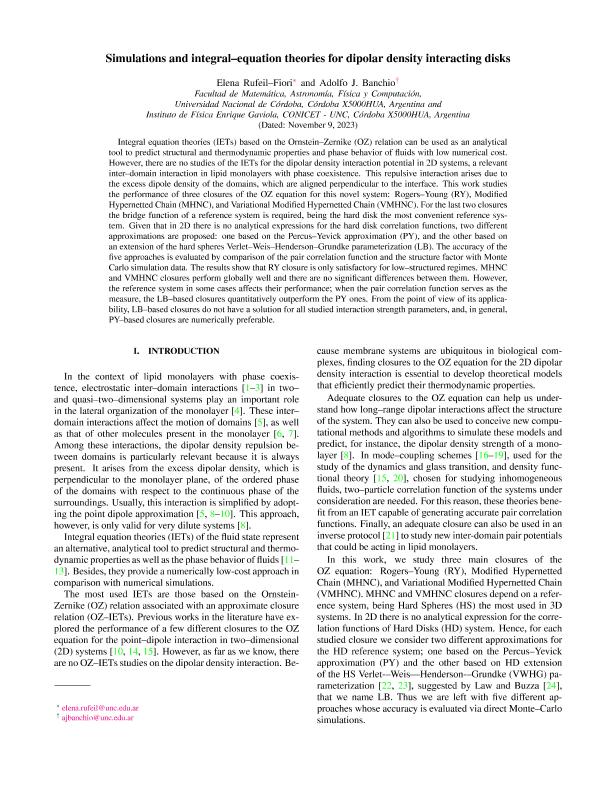Mostrar el registro sencillo del ítem
dc.contributor.author
Rufeil Fiori, Elena

dc.contributor.author
Banchio, Adolfo Javier

dc.date.available
2024-03-11T11:18:57Z
dc.date.issued
2023-12
dc.identifier.citation
Rufeil Fiori, Elena; Banchio, Adolfo Javier; Simulations and integral–equation theories for dipolar density interacting disks; American Physical Society; Physical Review E: Statistical, Nonlinear and Soft Matter Physics; 108; 6; 12-2023; 1-16
dc.identifier.issn
1539-3755
dc.identifier.uri
http://hdl.handle.net/11336/229960
dc.description.abstract
Integral equation theories (IETs) based on the Ornstein–Zernike (OZ) relation can be used as an analytical tool to predict structural and thermodynamic properties and phase behavior of fluids with low numerical cost. However, there are no studies of the IETs for the dipolar density interaction potential in 2D systems, a relevant inter-domain interaction in lipid monolayers with phase coexistence. This repulsive interaction arises due to the excess dipole density of the domains, which are aligned perpendicular to the interface. This work studies the performance of three closures of the OZ equation for this novel system: Rogers–Young (RY), Modified Hypernetted Chain (MHNC), and Variational Modified Hypernetted Chain (VMHNC). For the last two closures the bridge function of a reference system is required, being the hard disk the most convenient reference system. Given that in 2D there is no analytical expressions for the hard disk correlation functions, two different approximations are proposed: one based on the Percus–Yevick approximation (PY), and the other based on an extension of the hard spheres Verlet–Weis–Henderson–Grundke parameterization (LB). The accuracy of the five approaches is evaluated by comparison of the pair correlation function and the structure factor with Monte Carlo simulation data. The results show that RY closure is only satisfactory for low–structured regimes. MHNCand VMHNC closures perform globally well and there are no significant differences between them. However, the reference system in some cases affects their performance; when the pair correlation function serves as the measure, the LB–based closures quantitatively outperform the PY ones. From the point of view of its applica-bility, LB–based closures do not have a solution for all studied interaction strength parameters, and, in general, PY–based closures are numerically preferable.
dc.format
application/pdf
dc.language.iso
eng
dc.publisher
American Physical Society

dc.rights
info:eu-repo/semantics/openAccess
dc.rights.uri
https://creativecommons.org/licenses/by-nc-sa/2.5/ar/
dc.subject
monolayers
dc.subject
integral equaiton theory
dc.subject
density dipolar interaction
dc.subject
structure
dc.subject.classification
Otras Ciencias Físicas

dc.subject.classification
Ciencias Físicas

dc.subject.classification
CIENCIAS NATURALES Y EXACTAS

dc.title
Simulations and integral–equation theories for dipolar density interacting disks
dc.type
info:eu-repo/semantics/article
dc.type
info:ar-repo/semantics/artículo
dc.type
info:eu-repo/semantics/publishedVersion
dc.date.updated
2024-03-08T14:27:35Z
dc.identifier.eissn
2470-0053
dc.journal.volume
108
dc.journal.number
6
dc.journal.pagination
1-16
dc.journal.pais
Estados Unidos

dc.journal.ciudad
New York
dc.description.fil
Fil: Rufeil Fiori, Elena. Consejo Nacional de Investigaciones Científicas y Técnicas. Centro Científico Tecnológico Conicet - Córdoba. Instituto de Física Enrique Gaviola. Universidad Nacional de Córdoba. Instituto de Física Enrique Gaviola; Argentina
dc.description.fil
Fil: Banchio, Adolfo Javier. Consejo Nacional de Investigaciones Científicas y Técnicas. Centro Científico Tecnológico Conicet - Córdoba. Instituto de Física Enrique Gaviola. Universidad Nacional de Córdoba. Instituto de Física Enrique Gaviola; Argentina
dc.journal.title
Physical Review E: Statistical, Nonlinear and Soft Matter Physics

dc.relation.alternativeid
info:eu-repo/semantics/altIdentifier/url/https://link.aps.org/doi/10.1103/PhysRevE.108.064605
dc.relation.alternativeid
info:eu-repo/semantics/altIdentifier/doi/http://dx.doi.org/10.1103/PhysRevE.108.064605
Archivos asociados
